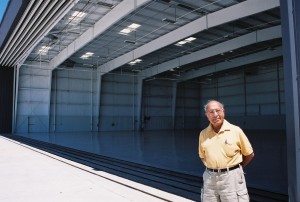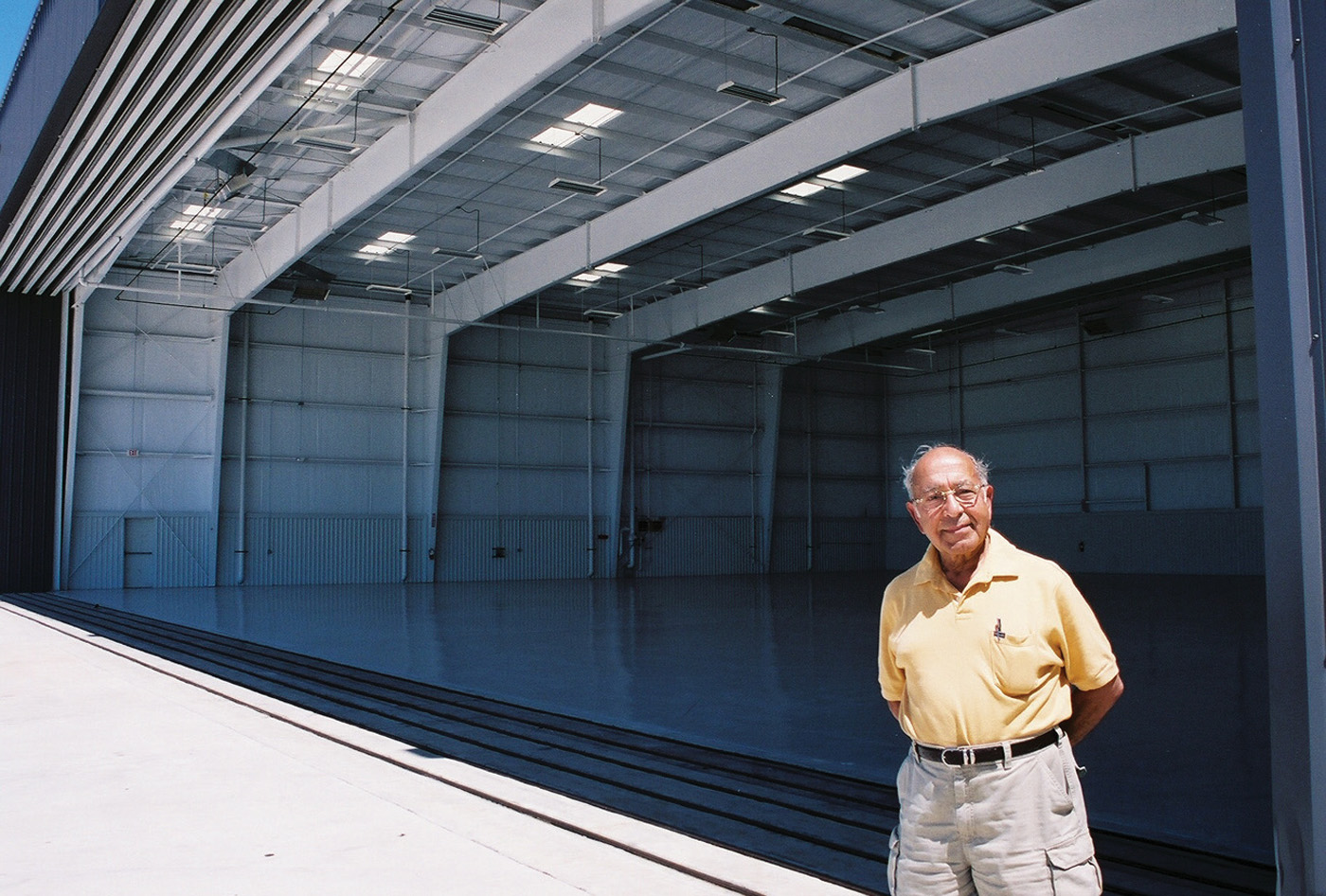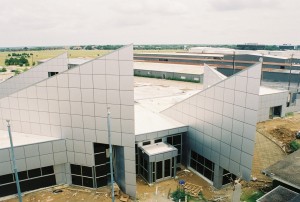By Dwayne Wilder

Ambassador Aviation owner Stanley Moussa stands in the newest addition of the Dallas Executive Airport FBO.
Directly south of downtown, Dallas Executive Airport (RBD) is coming alive. The airport sits on 1,026 acres near the intersection of US 67 (Marvin D. Love Freeway) and Hampton Road. There’s a U.S. Post Office adjacent to the airport and the Thurgood Marshall Recreation Center is across the street; a DART Park and Ride station, “Redbird Transit Center,” is within eyesight. It’s easy to find, too; that makes Dallas officials smile when they think about the possibilities.
“Our airport is getting a facelift,” said Lana Furra, RBD manager. “Everyone on the field has been supportive of the changes. We’re seeing commitment from everywhere.”
Furra, who has managed the airport since January, listed the renovations including a new 4,000-square-foot terminal building, which will have a restaurant complete with patio seating and conference center, as well as a pilot planning area and rest area for travelers. Other renovations include a new air traffic control tower, an expanded apron with new lights and paint and a new airfield maintenance facility.
According to the construction schedule, Furra estimated the new terminal and tower to open sometime this month; the apron will be complete in January 2006 and the maintenance facility should open in May 2006.
Furra noted the city will spend more than nine million dollars on the airport. In addition to the listed projects, runway enhancements include electrical rewiring, signage and new lights.
“Every single light is being replaced,” said Furra. “It’s a very challenging project.”
According to Furra, the configuration of the airport’s two runways—one 6,425 feet and the other 3,800 feet long—made the repairs at the intersection a “real challenge.”
“Milling and repairing at that intersection included repainting stripes and had to be done in phases,” explained Furra. “We were phasing it out hour by hour. But the alternative would’ve been to close it for a year.”
The runway enhancements were completed in August. The tower conversion will feature simultaneous operations of “old and new” towers for 60 days. The old terminal building and tower are scheduled to be demolished in December.
The former Redbird Airport became Dallas Executive Airport on Feb. 27, 2002. It sports three fixed base operations—Jet Center of Dallas, Ambassador Aviation and Cutter Aviation—and 25 tenants. In 2004, there were 93,460 operations at RBD.
Many are quick to note that RBD is “only 10 minutes and a stoplight from downtown Dallas” and only 15 minutes from the Park Cities area. It’s that location that makes the airport attractive to development and ultimately, business decision makers.
“We’re excited about its future; we’ve made significant investment in it,” said Terry Mitchell, City of Dallas assistant director of aviation operations. “We think the market is there for the airport to really prosper. It will significantly benefit the development of south Dallas.”
The City of Dallas has committed millions to develop the new terminal building, control tower and infrastructure improvements. Almost 500 acres—in various zoning classifications—are undeveloped. The potential is there for unprecedented growth and that bodes well for the Redbird area and all of south Dallas.
The airport is also the headquarters for the Dallas Police helicopter fleet. American Air Ambulance has a presence there and 200,000 square feet of hangar space is ready for lease.
“It’s a great location,” said Furra, an 11-year veteran of the City of Dallas’ aviation department. “It’s a diamond in the rough. We’re just waiting for an opportunity to shine. The enhancements and new construction will make this airport a happening place. We want to make this a vibrant general aviation airport.”
She said that RBD will be able to accommodate “everyone from corporate jets to sport fliers.”
Several tenants have been there through the changes, while others arrived after the commitment was made and renovations announced. But all see a future for the place left for dead not a decade ago.
“I think there’s a lot of promise with this airport, a bright future,” said Jeff Conkright, owner of JC Aviation Investment, Inc. “There’s been a lot of new investment in the last five years. I think the growth and competition is good; this airport is a tremendous asset that the common public doesn’t know about.”
He added that marketing the airport—along with the renovations—will make the difference.
“The problems before were bad management, bad leadership, but the new supportive efforts of the city’s aviation department are positive,” said Conkright, a pilot, aircraft mechanic and aviation businessman.
Conkright, who has been at RBD since 1981, said he first saw the examples of lackadaisical attitude toward the airport a decade ago. When the aircraft salesman turned businessman went before the authorities asking to start a new endeavor at the airport, his request for a long-term lease was denied.
“Basically, they weren’t sure they wanted to keep an airport here,” he said of the Dallas City Council. “But it needed to happen. This airport needed support from the city and the council, and they needed to support south Dallas, too.”
He has since obtained that lease and now has 10 hangars that hold 50 airplanes; every spot is full. He said that’s a good indicator the airport is on the right track.
David Webb, a retired orthopedic surgeon who’s been at Dallas Executive since 1989, keeps a North American T-6G at the airport. He only lives five minutes from Love Field but makes the trip to RBD because he considers it a better airport.
“Dallas Executive doesn’t have as much identity as Love, but I think it’s great,” said Webb, who learned to fly when he was 16 years old. “It’s an upbeat place, but will people use it?”
Webb said the management of RBD has been “bad” over the years but that it has been on the right track in the past few years. He’s stayed for the duration to pursue his hobby, and that’s the bottom line: It’s a good place to be for flying.
“This airport has always been about change—sometimes good and sometimes bad,” he said.
One of the larger operations at Dallas Executive is Cutter Aviation. Andy Biery, operations manager, has seen the hangars used as flea markets and chop shops over the years.
“The city was derelict in its responsibility in managing this asset,” said Biery from his second-floor office overlooking the tarmac and new tower. “The concept of private management was right, but it didn’t work either.”
He added that about five years ago the city took RBD back under its tutelage. But Biery is still concerned that the airport—and its renovations—can’t compete on its own merits since the city also operates Love Field and the heliport downtown.
“It’s not autonomous,” explained Biery. “My task, as a business, is to promote myself. In a perfect world, I wouldn’t be hindered by other airports and be able to do just that.”
He added that Cutter will continue to compete within the system and let the benefits of Dallas Executive stand for themselves even against the likes of Love Field. Cutter Aviation, a national company with one location in Texas, is the Texas authorized facility for Piper aircraft as well as the Beechcraft Authorized Service Center for north Texas. At any time, there are several multimillion dollar airplanes at the facility.

RBD tenant and pilot David Webb prepares to take his North American AT-6G for a flight. The aircraft is a veteran of World War II and served in the Spanish Air Force for 25 years.
“There’s so many products in this area; Cutter came to support them,” explained Biery. “We love being here. This airport lends itself well to what we do here. We can always fly and land here even in bad weather.”
He added that RBD isn’t “so overcrowded” and is a good place to train pilots. According to Biery, Cutter came to the airport the month it changed its name in 2002.
“The focus had changed by then,” he explained. “The city marketed it to us with their efforts to transform the airport.”
He added that the commitment will allow the airport to succeed and only get better.
Biery touted the full-service emphasis at Dallas Executive as well as its location. The smaller Addison Airport and Love Field just can’t compete, he concluded.
“It means the convenience of having your airplane worked on by someone who cares,” said Biery. “It means having it always ready when you want to fly.”
Stanley Moussa believes in Dallas Executive so much that he started construction of a new FBO this year. Moussa and his son, George, founded Ambassador Aviation at RBD in 2003. They spent $1 million to build its first facility and have watched the increased commitment to the airport come to pass.
“We want this airport known,” said Moussa. “We will put in over $4 million in improvements of our own. This is a paradise that needs to be discovered.”
His experience with the airport is one of admiration. Moussa admits he’s seen only the recent “good” side of what’s happening to RBD.
“The changes have been great. The city is spending a lot of money, building a state-of-the-art terminal and tower,” Moussa explained. “There’s new runway lighting and open development for large corporations.”
When looking for an airport to use for their wholesale furniture corporate jet, the Moussas were drawn to Dallas Executive and saw the potential right away.
“We believe in this airport and its future,” said Moussa. “The future looks great.”
Moussa also believes that the marketing of the new look of the airport will be the key to its new stature throughout the state.
“There needs to be additional action by the city council, tax abatements and tax relief to help businesses relocate here,” explained Moussa. “We want to bring it to the people of Dallas and the aviation industry.”
The Cairo-born Moussa didn’t mind delaying his lunch hour to discuss the merits of Dallas Executive and Ambassador Aviation as part of the “newness” of the south Dallas growth.
“I like this airport!” he said, emphasizing every word.
Many business owners at the airport look to the facility as a touchstone for the future of the entire Redbird-Oakcliff-south Dallas area. Development will bring people and the people will bring a healthier economy.
Conkright is adamant that what’s happening goes beyond Dallas Executive, but the airport is where it has to start. He said marketing is the key because usually businesses had to be wooed to set up base at the airport.
“The city council needs to promote it and promote the southern sector, not just the northern,” he continued. “We have to change the approach; businesses had to be solicited to come here, but after a couple of months they’re elated with this airport.”
Conkright believes the airport’s new look is a step in the right direction.
“Every city has an area that needs development. That’s south Dallas; that’s Redbird,” he said. “We just need to get the word out.”
Furra agreed that the changes at RBD will help boost the southern sector of Dallas. She noted the upcoming Trinity River Project as another example of the emphasis on southern Dallas development.
“The aviation department is doing its part,” she said.
When the City of Dallas took management of the airport back in 2002, the name was changed to associate the change with the improvements and new commitment for the south Dallas site. Mitchell said the new name better reflects the focus and target market of the facility.
“They wanted to turn the page and move forward,” Furra added. “They decided to do something.”
According to Furra, there are no capital improvement project funds for the airport, but some are due in 2006-07. She’s ready to get the facilities done and opened to start that new chapter in the life of a longtime Dallas landmark.
“I’m very proud, busy and exhausted,” she smiled. “Dallas Executive is such a great airport. I’m looking forward to seeing what opportunities come our way when we’re done.”













